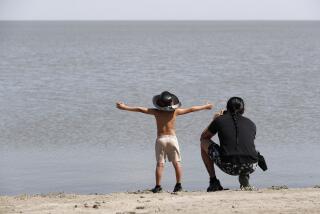Shrinking Lake Chad Targeted for Rescue
- Share via
N'DJAMENA, Chad — Seen from an airplane, the only major body of water in the heart of Africa could be mistaken for a mirage, a mirror shimmering in the desert.
Lake Chad, whose name in the Kanuri language means “great body of water,” millions of years ago covered 132,000 square miles, or one-quarter of the African nation that now bears its name.
But although a subject of much speculation and curiosity on the part of European explorers, it failed to appear in detail on maps of the continent until the late 19th Century.
Today, fears are growing that the changing world climate and rampant desertification will combine to dry up the lake, leaving behind only a memory of its outline in the Sahel region south of the great Sahara.
Several million fishermen and farmers in Chad and other countries depend for their livelihood on the lake that has shrunk to about 3,200 square miles. Last year Chadians alone pulled 100,000 tons of perch and catfish from the lake for smoking and shipping to the rest of the country.
Natron, a mineral extracted from the lake for fertilizer, is sold in gunny sacks to merchants in N’Djamena’s bustling market for shipment south to Chad’s best agricultural land.
During the seventh summit of the 26-year-old Lake Chad Basin Commission in Yaounde, Cameroon, earlier this year, the presidents of Chad, Cameroon and Nigeria urged increased international aid to save the lake and the area that depends on it.
Experts at the meeting suggested, however, that the governments of the countries bordering the lake have themselves neglected its resources because of simmering disagreements over boundaries and a civil war.
Jacques Lemoalle, a French government hydrobiologist, spent 1963 to 1977 studying Lake Chad and returned recently to check reports that the lake was fading away.
“Since 1967, the lake has been shrinking progressively. The most remarkable decline was at the end of the 1968-72 drought when high spots on the floor began sticking out, effectively dividing the lake in two,” he said in an interview.
Lake Chad is fed from the south by the Chari River, which rises in the Central African Republic and is then joined by the Logone.
The Chari is gorged with water during the rainy season, usually July to October, but then recedes to a sluggish, meandering course that seems to take forever to reach the marshy, reed-filled lake.
“The whole basin is a relatively unstable system,” Lemoalle said. “This is the third time the lake has been this small since the beginning of the century.”
The African Development Bank is funding a 5-year, $20-million program to pump new life into an earlier Lake Chad project. A first group of experts in irrigation and vegetable farming arrived earlier this year to advise on more efficient ways of growing millet, sorghum and okra, staples of the region.
More to Read
Sign up for Essential California
The most important California stories and recommendations in your inbox every morning.
You may occasionally receive promotional content from the Los Angeles Times.













